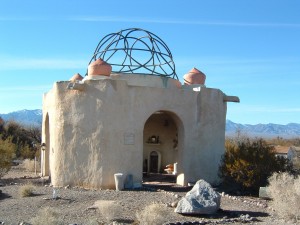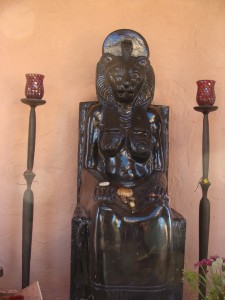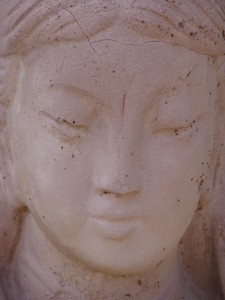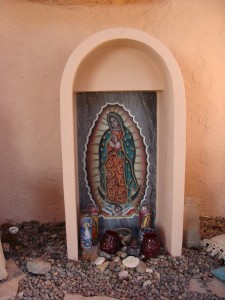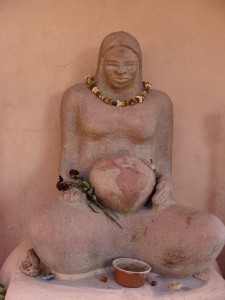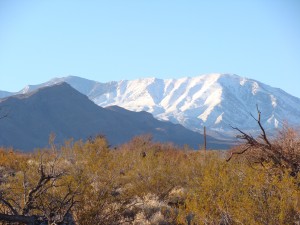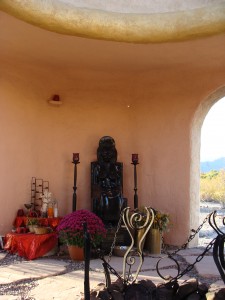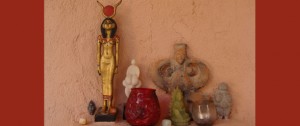My Journey with Sekhmet, Goddess of Power and Change
by Genevieve Vaughn
Highway 95 runs down the middle of the flat Mojave Desert valley in Nevada. Driving east from Beatty, the tiny oasis of Cactus Springs is the first inhabitable spot for sixty miles. It was at this site in 1993 that I dedicated a temple to the Goddess Sekhmet. I feel blessed to be able to give a gift to a goddess who for centuries has not had temples built in her honor.
A surprising amount of information can be derived from what we know about Sekhmet. She is an ancient goddess; with her lion’s head and woman’s body, she is the opposite of the Sphinx who has a man’s head and a lion’s body. Sekhmet is the goddess of four thousand names, of which only a few hundred are known to normal humans.
One story about her is that she was outraged at the evil of men and wanted to destroy them but was tricked into submission by drinking a gift of beer which had been colored to look like blood. This is a particularly appropriate warning for us now, because we allow ourselves to be drugged into giving up the political and economic power that we could use to stop the destruction of the Earth. It is good to have the temple near the Test Site, to take a stand against the nuclear radiation that can damage our genes and destroy our fertility. The spirits of the past are counting on us to heed Sekhmet warning, to stop sipping the drugs of lies and allowing ourselves to be disempowered by consumerism or substance abuse.
Sekhmet is “Mother Fury” and the goddess of fertility. She is the great Being in us all, the liberated planetary human animal who will not allow the destruction of a Mother Earth. We can be strengthened by chanting her mantra: “Sa Sekhem Sahu.” Although the Temple was constructed in 1993, I feel that I honored Sekhmet for many years before the Temple was created. I was brought up a Catholic, but early on I believed mostly in fairies. Daddy told us stories about Robin Goodfellow and his fairy band, and my mother encouraged the fantasy. We lived next to the bay in Corpus Christi, Texas. I always fairies would have felt at home there.
When I was about twelve my grandfather died. He left a large inheritance to his children and grandchildren and as a result many changes happened in my life. We moved to a bigger and less fairy friendly house closer to town. The border between Texas and Mexico was not too far south of us, and my parents sometimes took us down to Brownsville and Matamoros for the weekend. There were lots of children my age and younger on the Mexican side of the border, begging. I began pretty early to ask myself why they were poor and we were rich. Even though my parents were relatively tolerant, the message I received was that we were rich because we were industrious and lucky, while other people were poor because they were lazy and unlucky. It was many years before I realized that there was a actually a transfer of wealth going on from the poor to the rich.
As a teenager I became an atheist; later when I married an Italian philosopher and moved to Italy, my belief system turned toward humanism as the source of divine in my life. During the twenty years that I lived there, Italy was a country of intellectual and political ferment. Always a crossroads, it was the location of the largest Communist Party in the West as well as the Vatican. I became a Marxist myself for a while until I came to believe that Communism, like Capitalism, is patriarchal and that Feminism is a collective philosophy which is deeper and has more potential for positive change than either of them.
In Italy I began to understand that our economic system actually hurts everyone. Each individual has a place on a great wheel that creates privilege for some and hardship for others; a few profit by the suffering of the many. The system actually molds individuals in its image, perpetuating itself and offering rewards and punishments that motivate individuals to try to get to the top of the wheel. It also creates ways of thinking and believing which complicate and disguise this rather simple picture, keeping the people involved from knowing what is going on.
As a person at the top of the wheel, I resented the system and the disguise because I did not want to cause other people’s suffering. Of course the belief system which upholds the wheel discredits altruism and the desire for a better world, making these values seem unrealistic. When I learned to validate my own values, I realized that “reality” would have to be changed. People who are on the wheel can trade places, or make small adjustments or improve their own attitudes, but none of this makes any real difference unless the wheel itself is dismantled.
In 1965 my husband and I went to Egypt on a vacation. We traveled up the Nile on a boat to Luxor and, at one point as we were exploring the temples, we came upon a statue of a goddess with a lion’s head who seemed almost forgotten, sitting on a throne at the bottom of a dark stairway. “This is the goddess of fertility,” the tour guide said. “Women who want to get pregnant should make her a promise.” I wanted to have children and had been trying without success so I silently promised the goddess I would build her a temple, a Taj Mahal. That very month I got pregnant with my first daughter, who was born in 1966, and I later had two more daughters. For many years I thought about my promise. On the one hand, I thought, building a temple was something I could do; people would want to honor the goddess of fertility. On the other hand there was no goddess consciousness at that time as there is now.
In 1978 I got a divorce and in 1983 I finally came back to the United States to try to create social change. While I was living in Italy I learned a lot about the effects of U.S. policy on the rest of the world, and I decided to come home to try to address problems closer to the source of power. Over the years I had thought a great deal about the economic “wheel” and how to change it. I developed a theory of patriarchy and identified its alternative as a woman-led gift economy based on the values of care and the affirmation of life. I decided to try to put my theory into practice.
I found the U.S. had changed a great deal while I had been gone. The Civil Rights, Feminist, New Age and Women’s Spirituality movements had all begun, and there were small but valiant groups everywhere working against the nuclear arms race, against U.S. Intervention in Central America, against militarism, and for racial, environmental and economic justice. I began to practice my theory of gift-giving with the money I inherited from my parents and grandparents, using it to initiate and maintain many woman-led projects for social change both locally and globally. For about ten years I also contributed to a number of other peace groups. Just as importantly, when I came back I experienced a major personal transformation. I encountered Goddess spirituality and my atheism disappeared. Since then I have been open to the integration of the part of myself that loves humanity and the earth with the part of myself that loves the Goddess.
I realize now that my atheism mostly had to do with a rejection of patriarchy, and I welcome the return into my life of nature spirits, the spirits of the dead, archetypal and elemental energies, and the consciousness of the planet. This change in perspective allowed me to recognize Spirit as a gift-giving or mothering presence while at the same time the legacy of my atheism and belief in humanism, continued to make me take social change very seriously. It also let me continue to support and love people who have other cultural legacies and belief systems. Combining earth-based spirituality and a radical feminist theory of social change was part of the motivation that led me to start the Foundation for a Compassionate Society in 1987.
Using money for social change is like speaking words of power. With little physical effort, the stroke of a pen on a check can create great change. Of course it is also important to speak the words of power, to do ceremony and ritual and act in accordance. The demonstrations, lobbying, media work, speaking tours, consciousness raising, the gathering of women from different cultures to share their intent and commitment for a better world, are all at some level rituals for peace. By providing spaces where these activities can be done free or low cost, central points are created around which the intention for change can swirl, essential connections can be made, deep energies expressed. Throughout the years I have supported and maintained many of the rituals, but I have also created many spaces that offer their services to the public in an ongoing way. I consider them to be crystallized energy, physical spaces established with a radical intent change reality. Stonehaven Ranch, the Austin Women’s Peace House, Alma de Mujer, Center for Social Change, the Four Directions Stores, the Grassroots Peace Building, WATER (Women’s Access to Electronic Resources) House, The Living Well, Casa de Colores were or are in their various ways sacred spaces, temples to Sekhmet. These were temples to the goddess in all of us who fiercely protects life on this planet.
For a while I comforted myself with the idea of these metaphorical temples, but when I began going to the protests at the Nuclear Test Site in Nevada in 1986, I felt the need to have concrete representations of our love for the planet nearby. I commissioned indigenous sculptor Marsha Gomez to create a statue of Mother Earth to place in front of the test site gates. Unfortunately the government almost immediately confiscated Madre del Mundo. I knew almost at once that this was the right place to build a temple to the goddess. The Earth at the Test Site is wounded underground. You can feel it in your body as you stand at the gate of the test site looking some forty miles across the desert at the hills behind which the testing takes place. The nuclear tests in Nevada, which began above ground in 1951, were moved underground in 1963. They were finally stopped in 1992 but then recommenced with the so-called “sub-criticals” in 1997. Mother Earth is injured there, and nuclear waste is being stored in her wounds. Our group has created several “wailings” at the gate to the Test Site. We name the things we mourn for and moan and scream our grief like banshees. We mourn for our mothers, for our daughters, for your grief, dear reader, and especially for the grief and pain of the great Mother.
All the land where the Test Site sprawls once belonged to the Western Shoshone. In the treaty of Ruby Valley of 1863, the government promised to give back the land to the Shoshone, but they didn’t act in accordance with their word. In fact the U.S. government has never honored any of the treaties they have made with the native peoples of this country. The Shoshone continue to protest there. Their main events are the Healing Global Wounds gatherings which take place twice yearly at the gate in spring and fall. I decided that the Nevada desert was the right place to finally act in accordance with my own nongovernmental woman’s word to the Goddess Sekhmet.
I realized that there was much more land there than we would need for the small temple and so I gave it back to the Western Shoshone to whom it belonged before the gradual encroachment of the settlers seized it from them. It was a very happy moment for me when I participated in the ceremony of giving-back-the-land held by the Shoshone in 1992 during their commemoration of the 500 years of colonial oppression since Columbus.
The site of the temple is powerful for many reasons. Built on the very edge of the Nevada Test site, it is also three miles west of Indian Springs, which houses an Air force Base, and about eight miles from a Federal Prison. About forty-five miles more traveling will get you to the suburban outskirts of Las Vegas. One gets the distinct impression that the oppressive forces responsible for the test site are uncomfortable with Sekhmet’s proximity. With seeming ill-will, anti-tank helicopters called “wart hogs” and F111 jets fly low over Cactus Springs on their practice flights, momentarily disturbing the silence. You can watch them buzz the tiny temple which is set back from the highway about a thousand feet. Hundred-year-old cottonwood trees dot the oasis. Sweet-smelling creosote bushes, mesquite trees and salt cedars drink from the precious underground water. Many birds and wild animals participate in the delicate and beautiful ecosystem.
The temple was built in 1993. Several months of construction were necessary to lay the foundation in the shifting sand, to arrange the straw bales and cover them with stucco. I tried to employ women whenever possible. Architect Molly Neiman took my Taj Mahal idea and designed a small and environmentally appropriate structure with simple lines. Yole Reyes, Pamela Overeynder and Jody Dodd managed the site, while a group (called CHAOS) of young peace activists, mostly women, did the actual construction. Later a dome made of seven interlocking copper hoops was made by Richard Cottrell, and four turrets were constructed by ceramist Sharon Dryflower. The temple houses a statue of Sekhmet made by Marsha Gomez, and facing her is the Madre del Mundo statue that we originally placed at the test site in 1987. Smaller statues of goddesses of many cultures adorn the walls.
The temple is small and open to the weather, with four large arches opening on the four directions, yet inside there is a sense of spaciousness and protection. Gifts of fresh flowers, feathers, crystals, incense, poems and pictures of loved ones from the visitors, pilgrims and activists are placed at the feet of the goddesses.
The goddess has called wonderful women to maintain the space and create ritual there, while I continue my life elsewhere. The first caregiver was Cynthia Burkhardt, who began watching over the temple in 1993 and who lived in a teepee on the land. The next year, when Cynthia decided to leave, crone witch Patricia Pearlman offered to step in and was priestess of the temple until 2004. Patricia provided a full Wiccan calendar of events honoring the Wheel of the Year, with eight Sabbats, and thirteen full and thirteen new moons. In addition, she performed all rites of passage plus a variety of healing and settling rituals as the need arises, and a children’s hour with stories and teachings from different cultures has recently been introduced. After Patricia, Dr. Anne Keys became the resident priestess for three years. She integrated her academic training into her priestessing, and started large yearly events to which the public is invited. In 2007, Candace Ross took up the duties of the priestess, maintaining all the Wiccan events. She has also brought forward the activist potential of the temple, as a place of participation in the movements of nonviolent protest for a world without war and nuclear weapons.
A community of Wiccans mostly from Las Vegas attend the temple rituals regularly. Many solitaries also come to the temple, which is always open to the public. Other pagan groups from near and far occasionally ask permission from the resident priestess to hold rituals there. Activist and environmental groups use the land for meetings and the temple for meditation. Many meet on the land in the spring before the Healing Global Wounds gatherings. Peace marchers organized by the Shundahai network and the Nevada Desert Experience stop and rest on their way to the test site.
The temple holds its ground in the midst of many negative energies. Like the land herself, the temple’s energies remain positive, delicate, down to earth, and sane. Patricia used to say, “People find the temple when they are ready, they come from all over. We welcome everyone and the only thing we expect them to pay is respect.” The community gathers for rituals, and afterward there are potluck feasts, conversation, singing and drumming. There are two trailer houses on the land that I rent from the Shoshone. One of them is the residence of the priestess and the other is for women guests of the temple.
Patricia was very attuned to the Goddess. She told us that “Sekhmet is sensitive, amorous, playful, sensuous, and beautiful. She is also strong, a no-nonsense goddess. She is creator and destroyer, the mother of all and the gardener weeding the garden. Other goddesses correspond to some of her thousands of unknown names. People who have difficulty with abstractions can relate energies to her image, to the lion, the fire and the cow (her Hathor aspect). In Sekhmet, it is said, the Creator decided to incarnate as a lion to experience what she had made, like a woman eating a piece of the pie she has baked.”
I believe that human spirituality is actually based on the gift economy of Mother Earth and I believe that the priestesses who have cared for the temple and the community are succeeding in practicing the gift economy in alignment with that Way. I am trying to promote gift-giving at other levels too, in woman-led alternatives to patriarchal capitalism. I am happy to find myself in agreement with the priestesses in believing that life is not so much a school as an experience of giving and receiving, not a series of moments of paying back but an opportunity to take risks and create change.
Twenty years have passed and many things have changed. The Foundation for a Compassionate Society is now closed. I am living far away but still working on the theory of the gift economy as a maternal economy, a basis for social change, and I continue to honor Sekhmet and support Goddess spirituality and her temple.
Blessed Be!

